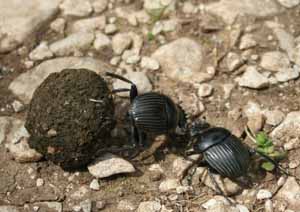摘要:一项由西班牙科学理事会(Consejo Superior de Investigaciones Científicas, CSIC)做的调查发现,在冰河时期后期发生的重大冰川撞击至今还影响着甲虫金龟子家族(Scarabaeidae)的分布。发现于欧洲的这类甲虫的似乎更多的受到冰川气候的影响,而不是目前的气候状况。

Dung beetle
The study, published yesterday in the journal Ecology Letters, analyzed the species richness and the structure of their communities throughout the different regions of the European territory from the Ural Mountains to the Iberian Peninsula. The selection of this family of insects was motivated by their high dispersal ability and because their food sources (mainly cattle and sheep dung) are present throughout the continent.
Scarabs are insects of tropical origin that cannot survive below 0 ° C mean annual temperature, "so it could be expected that their presence gradually decreases as temperatures drop down northwards " says the researcher from the National Museum of Natural Sciences, CSIC, Joaquín Hortal. However, the analysis of the relationship between the magnitude of climate change since the last glaciation and the distribution of scarabs evidences that these insects are not evenly distributed according to this gradient, but rather show two different patterns, one in the north and one in the south. Horton said: "The border defining the two areas is almost similar to the limit of 0 °C of mean annual temperature at the time of the last ice age."
Although scarab species richness is actually lower in the north that in the south, two other characteristics can be explained under the hypothesis of the influence of the last ice age.
The first one is based on the species present throughout Europe. Data show that all scarab species living in the northern territory above the border defined by the 0 ° C limit in the last glaciations are also present in the south, and there is no species exclusive to the northernmost area. According to Hortal, "this is an effect of the difficulty of adapting to cold climate that still exists, as the north does not hold unique species adapted to the cold."
This feature is consistent with the second observation, based on the age of the species present in each area. The study results show that the species that have been able to re-colonize the north are also those that have evolved most recently." Although the adaptation to cold climates started before the last glaciation, these species belong to the newer phylogenetic branches of the Scarabaeidae," says the researcher from CSIC.
Shared influence
The current distribution of scarabs in Europe demonstrates, therefore, that certain influence of the last ice age is still maintained. According to Hortal, "it is not that the current climate does not affect biodiversity, but rather that the impact of past climate change is hiding under the influence of present conditions." The reason why such impact has not been detected so far is that both cause similar effects, i.e., less species in the North of Europe. The CSIC researcher says that: "current biodiversity patterns are therefore a mixture of past climate effects, current conditions and the evolutionary history of the species."
The results of this investigation show that the consequences of major climate changes persist over a very long term. According to Hortal, "this work should be taken into account when analyzing and forecasting the consequences of the global warming currently experienced by the Earth." The researcher concludes: "If the temperature continues to rise, some climates that never occurred during the recent history of our planet may appear, and we do not know which species, both animal and plant, will be able to adapt to them; in fact, it is possible that many of them will not be able to live in these new climates."







